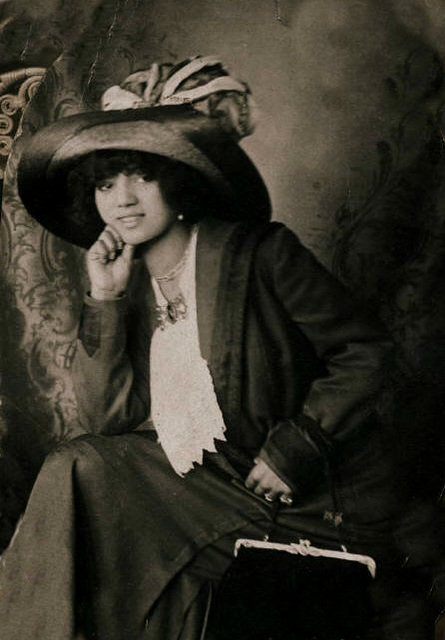Burial of a Fighter
Lady in Mourning
Janie Garner Burruss
Jacksonville Old Folks Home
Editor of the Freeman
Opportunity
Vintage Lady
Class of 1891
William D Foster
George Walker
Griffin Sisters
Black Herman
Orpheus M McAdoo
State of Virginia's First
Murray Bros. Printing Co.
Vintage Sisters
Vintage Miss
Soldier
Josephine Baker
Josephine Baker
Students from Covert School
Mary Henrietta Graham
Sarah Lewis
Leah Pitts
Irene Morgan Kirkaldy
Oriental Opera Company
Lily Yuen
Hazel Meyers
Anna Madah Hyers
Aida Ward
Maude Russell
Belle Davis
Cleo Desmond
RomeoL Dougherty
Montrose Sisters
Belle Fields: The Black Nightingale
Anise Boyer
Aurora Greeley
Madam Estelle P Clough
An Overlooked Blues and Jazz Pioneer
Bessie and the Dancing Sheiks
Helen Louise Dillet Johnson
Cousins
Jam Session with Jazz Giants
Billie Holiday
See also...
Authorizations, license
-
Visible by: Everyone -
All rights reserved
-
14 visits
Semoura Clark


Semoura Clark, was a vaudevillian, who along with her sometime stage partner 'Bonnie' Clark (who was actually a male in drag) provided segregated entertainment for blacks in the South and Midwest. Photographs and ephemera from the Bonnie and Semoura Clark contains photographs and ephemera depicting predominantly black vaudeville acts including photographs of chorus girls, minstrels, and cross dressers, handbills and programs and two ink and wash drawings of Bonnie and Semoura Clark, dated 1913. Other popular entertainments competed with the vaudeville theater circuits for the attention of the American public. Long before the addition of kooch dances and striptease, early burlesque shows were famous for their “lady minstrels” and grand choruses of girls In flesh-colored tights. The burlesque stage was also known for its comic parodies of classical and popular drama and its own version of the full-cast finale, known as the Amazon parade.
In popular plays of the period, realism was the vogue. To effect a sense of reality, real objects and animals were substituted for stage props; all manner of things appeared on stage—from horses to trees to fire engines. One company performing Harriet Beecher Stowe’s Uncle Tom’s Cabin boasted the appearance of real hunting dogs. Historic events in the expansion of the America West were reenacted on stage as western melodramas by the Buffalo Bill Combination, led by the famous frontiersman, William F. Cody. These sensational, if often historically inaccurate, popular stage shows were soon moved to outdoor arenas. Wild West shows became a staple in American entertainment, but the most famous by far was Buffalo Bill’s Wild West Show.
Ruckus! American Entertainments at the Turn of the Twentieth Century and the Bonnie and Semoura Clark Black Vaudeville Collection recall these popular divertissements in all their variety and vivacity and celebrates the performers, both the famous and the forgotten, who were at the heart of the period’s most lively amusements.
Sources: Bonnie and Semoura Clark Black Vaudeville Photographs and Ephemera. James Weldon Johnson Collection in the American Literature Collection, Beinecke Rare Book and Manuscript Library, Yale University
In popular plays of the period, realism was the vogue. To effect a sense of reality, real objects and animals were substituted for stage props; all manner of things appeared on stage—from horses to trees to fire engines. One company performing Harriet Beecher Stowe’s Uncle Tom’s Cabin boasted the appearance of real hunting dogs. Historic events in the expansion of the America West were reenacted on stage as western melodramas by the Buffalo Bill Combination, led by the famous frontiersman, William F. Cody. These sensational, if often historically inaccurate, popular stage shows were soon moved to outdoor arenas. Wild West shows became a staple in American entertainment, but the most famous by far was Buffalo Bill’s Wild West Show.
Ruckus! American Entertainments at the Turn of the Twentieth Century and the Bonnie and Semoura Clark Black Vaudeville Collection recall these popular divertissements in all their variety and vivacity and celebrates the performers, both the famous and the forgotten, who were at the heart of the period’s most lively amusements.
Sources: Bonnie and Semoura Clark Black Vaudeville Photographs and Ephemera. James Weldon Johnson Collection in the American Literature Collection, Beinecke Rare Book and Manuscript Library, Yale University
- Keyboard shortcuts:
Jump to top
RSS feed- Latest comments - Subscribe to the comment feeds of this photo
- ipernity © 2007-2024
- Help & Contact
|
Club news
|
About ipernity
|
History |
ipernity Club & Prices |
Guide of good conduct
Donate | Group guidelines | Privacy policy | Terms of use | Statutes | In memoria -
Facebook
Twitter
